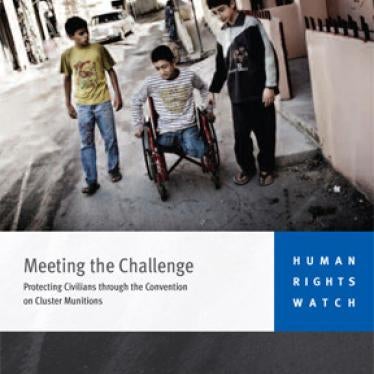(Geneva) - The Convention on Cluster Munitions is the only viable solution to ending the scourge of cluster munitions, Human Rights Watch said in a new book released today. As diplomats in Geneva opened discussions on a weak alternative, Human Rights Watch said that eliminating the harm caused by these inhumane weapons requires the absolute and comprehensive ban contained in the convention.
The 224-page book, Meeting the Challenge: Protecting Civilians through the Convention on Cluster Munitions, is the culmination of a decade of research by Human Rights Watch. It details the humanitarian toll of cluster munitions, analyzes the international process that resulted in the treaty successfully banning them, and presents the steps that nations that have signed the convention should take to fulfill its promise.
"The facts on the ground leave no doubt that cluster munitions inevitably kill and maim many civilians," said Bonnie Docherty, senior researcher in the arms division at Human Rights Watch. "Nations serious about stopping this suffering should join the ban convention and not settle for ineffective half-measures."
Meeting the Challenge draws on Human Rights Watch's field investigations to document the burdens cluster munitions impose on civilians and on its firsthand experience as an active participant in developing the 2008 Convention on Cluster Munitions.
Cluster munitions have been causing high numbers of civilian casualties since their first major use in the Vietnam War about a half century ago, and they have left large tracts of land contaminated with landmine-like unexploded ordnance for decades. Widespread proliferation and repeated use has made the issue one of global concern, Human Rights Watch said.
Cluster munitions are large weapons that disperse dozens or hundreds of small submunitions. The submunitions cause civilian casualties during strikes, especially those in populated areas, because they spread over a broad area, hitting civilians as well as soldiers. In addition, many of the submunitions fail to explode and linger like landmines, often killing or wounding civilians, especially children and farmers, for years afterward.
The Convention on Cluster Munitions addresses all of these problems, Human Rights Watch said. It categorically bans use, production, transfer, and stockpiling. It also requires stockpile destruction, clearance of unexploded submunitions, and victim assistance. The convention currently has been signed by 108 nations, 46 of which have ratified, thus becoming states parties, fully bound by all its provisions.
Stepping outside of traditional UN diplomacy in 2007, governments and civil society collaborated to create the strongest treaty possible in just 15 months. The First Meeting of States Parties to the Convention concluded on November 12, 2010, in Vientiane, Laos, where delegates agreed to an ambitious 66-point action plan to fulfill rapidly all of the convention's obligations.
Yet some military powers continue to work toward an alternative instrument that would regulate, not ban, these unacceptable weapons. Such a protocol to the Convention on Conventional Weapons, being discussed from November 22 to 26, would create exceptions for broad categories of cluster munitions and establish lengthy transition periods.
"A watered-down protocol could undermine the power of the ban convention," Docherty said. "Countries should reject this approach once and for all."






